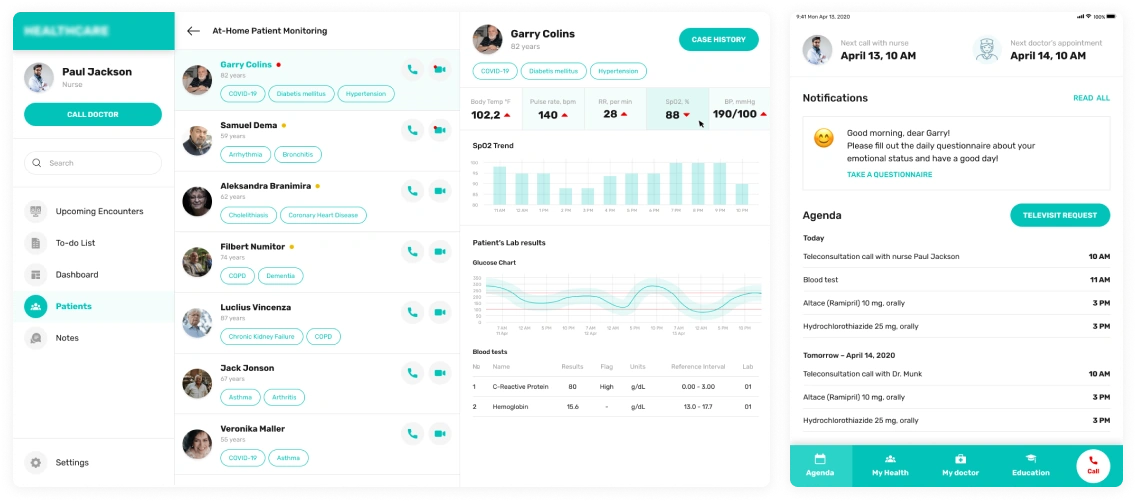Readmission is unpleasant for both patients and healthcare facilities. People are not happy when they must go to hospital again. For medical institutions, this means additional costs and labor. It is also a reputational loss: if a client turns for help again, s/he hasn’t been cured properly. It costs the industry $15,200 to treat one patient. Considering that there are about 3 million patients in the US every month, the cost will be enormous. That’s why organizations seek to reduce readmissions with the help of healthcare software. Let’s share some strategies.
According to a study carried out for the PLOS ONE research journal, doctors can prevent 5-79% of readmissions. Each medical institution seeks ways to reduce their number. Typically, hospitals do the following:
Implement virtual care
Using smartphones or laptops, specialists help people remotely receive treatment or recover after being discharged from the hospital. A discharged patient who develops complications or has unpleasant symptoms books a video consultation with a doctor. The doctor listens to complaints, studies the medical history, prescribes treatment, offers to monitor the state of health using an IoT device and a telemedicine platform.
A good example of how technologies can help to reduce readmissions is an EHR system with telemedicine functions ordered by an American home care company. Its clients obtained an application with embedded IoT functionality for remote patient monitoring.

Source: https://andersenlab.com/project-cases/advanced-ehr-for-home-care
The system warns nurses about any deviations in a patient’s state of health. A nurse communicates with the patient via chat, asks how s/he feels, and offers a video consultation with a doctor. The chat has an embedded speech-to-text recognition function which significantly facilitates communication. Thanks to the timely medical assistance and constant monitoring of health, the company managed to reduce the number of hospitalizations by 20% after the first six months of the EHR implementation.
Educate patients
A common cause of readmissions is a lack of clear instructions on rehabilitation upon being discharged from the hospital. It is difficult for patients to determine which symptoms are normal for their condition, and which ones need medical intervention. A patient must understand what is happening to his/her body.
Therefore, people should receive a comprehensive consultation on recovery upon discharge from the hospital. They must understand what medications are prescribed and why; what symptoms may occur during recovery and how to deal with them. When a patient is completely aware of his/her state of health, s/he doesn’t let it get worse and thus avoids readmission.
Such a simple and important mechanism of cooperation with patients helps to reduce the readmission rate by up to 45%. That is why hospitals include educational content in medical applications (articles, videos, chatbots, or webinars).
Digitize medical data
Medical institutions understand the importance of data accuracy and responsiveness for their work. A patient’s life depends on these two factors. Therefore, hospitals and clinics are digitizing medical records creating EHR/EMR solutions.
An electronic version of a medical record helps doctors to view medical histories, diagnostic and test results, chronic and genetic diseases, and allergies. Medical institutions can freely share EHRs when a patient needs urgent hospitalization.
The EHR system for US primary care medical centers has proved the efficiency of digitalization. Clients can make appointments online, consult doctors remotely, receive digital referrals for medical examinations and electronic prescriptions.

Source: https://andersenlab.com/project-cases/integrated-ehr-to-handle-patient-data
Patients no longer wait until diseases are gone. A smartphone is always at hand, and one can consult a doctor at any convenient time. As a result, the company reduced the number of hospitalizations by 15% after 12 months. The number of unnecessary laboratory tests decreased by 20% within the first 6 months of using the system.
Control readmission
To prevent readmission, medical institutions use predictive analytics tools. They segment patients into groups and identify those who show a high risk of complications. Doctors examine the peculiarities of a patient’s health, previous diseases, lifestyle, and offer recovery programs.
For example, the University of Kansas Health System used predictive tools to find out when people were readmitted to the hospital. It turned out that diabetics were more likely to be hospitalized again than other patients. Case managers assigned by the hospital helped them to secure follow-care. This decision helped to reduce readmissions by 11%.
The role of healthcare software in combatting readmission
The strategies listed above can only be implemented with the help of healthcare software. Medical organizations use the following applications:
- telemedicine platforms connect patients and doctors helping to remotely monitor health and provide medical assistance;
- remote patient monitoring systems are integrated with wearable devices and transmit information to attending physicians;
- for doctors, electronic medical records (EMRs) are a source of correct information about patients’ health;
- medical data analysis software helps to identify patients who risk developing diseases and warn them about scheduled examinations and screenings.
It is only with the help of electronic assistants that doctors can monitor their patients and control their condition around the clock. They can detect and treat illnesses before they become serious and require hospital care. There is one more reason why healthcare software is important for hospitals: due to the high percentage of readmissions, clinics are subject to fines from insurance companies. For example, in 2020 Medicare cut payments to 2,583 hospitals. Readmissions will cost healthcare facilities $563 million a year. Implementation of medical applications in hospitals and clinics is one of the ways of avoiding penalties from insurance providers.
Conclusion
In some cases, it is impossible to avoid readmission. For example, when a patient battling cancer undergoes planned treatment. In other cases, readmissions can be predicted and prevented using healthcare software solutions. Thanks to telemedicine platforms, EHRs/EMRs, and remote patient monitoring software patients are safe at home and receive high-quality medical assistance remotely. Thus, they don’t neglect their health risking getting in hospital. People are fully aware of their conditions and can positively influence their health under the supervision of doctors.
To choose a strategy that will help to reduce readmissions, you need to contact a healthcare software development company. Such an IT partner will suggest what kind of application needs to be implemented in your clinic to influence the readmission rate and improve patient care. The IT company will analyze the needs of your organization and create high-quality custom medical software.
